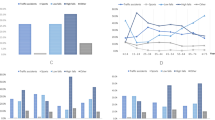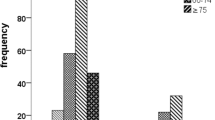Abstract
Study design:
Review of clinical data.
Objectives:
The objective of this study was to describe the clinical and demographical profile of patients with traumatic spinal cord injury (TSCI) admitted to a single center.
Setting:
Unidad de Medicina Física y Rehabilitación Centro, México.
Participants
Patients with TSCI attending rehabilitation for the first time.
Intervention
Not applicable.
Main measurements
Age, gender, educational level, occupational activity, causes of injury, level of injury, neurological level, injury severity and category were recorded.
Results
Four hundred and sixty-four clinical files of patients with TSCI were collected. The mean age was 37.9±15.9 years; 78.2% (363/464) were male, basic educational level predominated in 63.6% (296/464) and 73.1% (339/464) were employed. A fall was the main mechanism of the injury in 41.6% (193/464), replacing automobile accidents from the first place. The mean age of persons who suffered falls was 44±16 years. Injuries sustained by younger persons were due to violence (28.4±10.1 years) and the cause of injury associated with male gender was violence. Thoracic level was most often affected (in 56.7%, 263/464) and neurological level C4 in 13.4% (62/464). In regard to the extent of the injury, lesions classified as American Spinal Injury Association A predominated (56.2%, 261/464) as with complete paraplegia in 43.3% (201/464).
Conclusions
The mean age of our patients was 37 years. Men are affected in a higher proportion. Our population has <9 years of study. Physical labor was the usual pre-injury activity. The main mechanism of injury was falls. Thoracic spine was the most affected.
Similar content being viewed by others
Log in or create a free account to read this content
Gain free access to this article, as well as selected content from this journal and more on nature.com
or
References
van den Berg ME, Castellote JM, Mahillo-Fernandez I, de Pedro-Cuesta J . Incidence of spinal cord injury worldwide: a systematic review. Neuroepidemiology 2010; 34: 184–192 discussion 92.
Wong R, Espinoza M, Palloni A . [Mexican older adults with a wide socioeconomic perspective: health and aging]. Salud Publica Mex 2007; 49: S436–S447 Adultos mayores mexicanos en contexto socioeconomico amplio: salud y envejecimiento.
Kuhn W, Zach GA, Kochlin P, Urwyler A . Comparison of spinal cord injuries in females and in males, 1979–1981 Basle. Paraplegia 1983; 21: 154–160.
Rahimi-Movaghar V, Saadat S, Rasouli MR, Ganji S, Ghahramani M, Zarei MR et al. Prevalence of spinal cord injury in Tehran, Iran. J Spinal Cord Med 2009; 32: 428–431.
Pickett GE, Campos-Benitez M, Keller JL, Duggal N . Epidemiology of traumatic spinal cord injury in Canada. Spine (Phila Pa 1976) 2006; 31: 799–805.
Wyndaele M, Wyndaele JJ . Incidence, prevalence and epidemiology of spinal cord injury: what learns a worldwide literature survey? Spinal Cord 2006; 44: 523–529.
Jackson AB, Dijkers M, Devivo MJ, Poczatek RB . A demographic profile of new traumatic spinal cord injuries: change and stability over 30 years. Arch Phys Med Rehabil 2004; 85: 1740–1748.
NSCISC The 2012 Annual Stadistic Report. United States 2012 (cited 27 April 2014). Available from https://www.nscisc.uab.edu/PublicDocuments/reports/pdf/2014%20NSCISC%20Annual%20Statistical%20Report%20Complete%20Public%20Version.pdf.
Ho CH, Wuermser LA, Priebe MM, Chiodo AE, Scelza WM, Kirshblum SC . Spinal cord injury medicine. 1. Epidemiology and classification. Arch Phys Med Rehabil 2007; 88: S49–S54.
O'Connor RJ, Murray PC . Review of spinal cord injuries in Ireland. Spinal Cord 2006; 44: 445–448.
Kirshblum SC, Burns SP, Biering-Sorensen F, Donovan W, Graves DE, Jha A et al. International standards for neurological classification of spinal cord injury (revised 2011). J Spinal Cord Med 2011; 34: 535–546.
Ahoniemi E, Alaranta H, Hokkinen EM, Valtonen K, Kautiainen H . Incidence of traumatic spinal cord injuries in Finland over a 30-year period. Spinal Cord 2008; 46: 781–784.
Agarwal P, Upadhyay P, Raja K . A demographic profile of traumatic and non-traumatic spinal injury cases: a hospital-based study from India. Spinal Cord 2007; 45: 597–602.
Pagliacci MC, Celani MG, Zampolini M, Spizzichino L, Franceschini M, Baratta S et al. An Italian survey of traumatic spinal cord injury. The Gruppo Italiano Studio Epidemiologico Mielolesioni study. Arch Phys Med Rehabil 2003; 84: 1266–1275.
Pérez R, Martín del Campo S, Renán S, Durán S . Aspectos epidemiológicos de la lesión medular de la población del Centro Nacional de Rehabilitación. Revista Mexicana de Medicina Física y Rehabilitación 2008; 20: 74–82.
Sekhon LH, Fehlings MG . Epidemiology, demographics, and pathophysiology of acute spinal cord injury. Spine (Phila Pa 1976) 2001; 26: S2–S12.
Fekete C, Siegrist J, Reinhardt JD, Brinkhof MW . Is financial hardship associated with reduced health in disability? The case of spinal cord injury in Switzerland. PLoS ONE 2014; 9: e90130.
Paul C, Derrett S, McAllister S, Herbison P, Beaver C, Sullivan M . Socioeconomic outcomes following spinal cord injury and the role of no-fault compensation: longitudinal study. Spinal Cord 2013; 51: 919–925.
Dahlberg A, Kotila M, Leppanen P, Kautiainen H, Alaranta H . Prevalence of spinal cord injury in Helsinki. Spinal Cord 2005; 43: 47–50.
Lidal IB, Huynh TK, Biering-Sorensen F . Return to work following spinal cord injury: a review. Disabil Rehabil 2007; 29: 1341–1375.
O'Connor PJ . Prevalence of spinal cord injury in Australia. Spinal Cord 2005; 43: 42–46.
OCDE OECD Employment Outlook (cited 2 June 2015). Available from http://www.oecd.org/centrodemexico/estadisticas/.
Ku JH . Health-related quality of life in patients with spinal cord injury: review of the short form 36-health questionnaire survey. Yonsei Med J 2007; 48: 360–370.
Gosselin RA, Coppotelli C . A follow-up study of patients with spinal cord injury in Sierra Leone. Int Orthopaed 2005; 29: 330–332.
Krause JS, Terza JV, Erten M, Focht KL, Dismuke CE . Prediction of postinjury employment and percentage of time worked after spinal cord injury. Arch Phys Med Rehabil 2012; 93: 373–375.
Acknowledgements
We thank Antonio Barrera Cruz (PhD), Medical Programs Coordinator, Division of Clinical Excellence, Instituto Mexicano del Seguro Social, Mexico, for reviewing the article and suggestions in the statistics.
Author information
Authors and Affiliations
Corresponding author
Ethics declarations
Competing interests
The authors declare no conflict of interest.
Rights and permissions
About this article
Cite this article
Rodríguez-Meza, M., Paredes-Cruz, M., Grijalva, I. et al. Clinical and demographic profile of traumatic spinal cord injury: a mexican hospital-based study. Spinal Cord 54, 266–269 (2016). https://doi.org/10.1038/sc.2015.164
Received:
Revised:
Accepted:
Published:
Issue date:
DOI: https://doi.org/10.1038/sc.2015.164
This article is cited by
-
Morphine-induced changes in the function of microglia and macrophages after acute spinal cord injury
BMC Neuroscience (2022)
-
Epidemiological profile of 338 traumatic spinal cord injury cases in Shandong province, China
Spinal Cord (2022)
-
Epidemiology and clinical outcomes of spinal cord injuries at a level II trauma centre in Nigeria: a longitudinal five year study
International Orthopaedics (2021)
-
Epidemiology of traumatic spinal cord injury in Galicia, Spain: trends over a 20-year period
Spinal Cord (2017)



